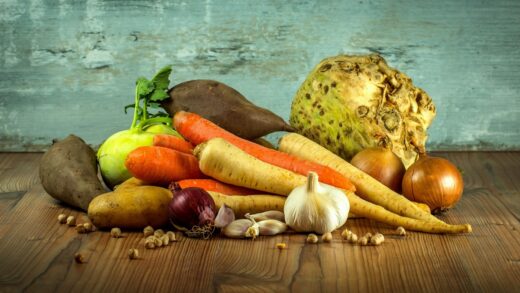A guide to growing your own vegetables tips, Growing food at home advice
A guide to growing your own vegetables
12 Mar 2021
In this guide, we’ll be talking you through the basics of growing vegetables, including where and when to grow them and we will also be sharing our top tips on the subject…
There are many benefits to growing your own vegetables:
- Knowing what chemicals are being used (or not used) on your food
- Saving money on groceries
- Being able to eat seasonally
- Reducing your carbon footprint by avoiding non-seasonal foods that have been shipped across the world
- To get back in touch with nature
- To be able to say ‘I grew everything on my plate’
Today, we’re going to talk you through the two most important factors of growing vegetables:
- Choosing where to grow your vegetables
- Choosing when to grow your vegetables
We will also be sharing some of our top tips to increase your harvests.
Where can I grow vegetables?
There are three main options when it comes to choosing where you should grow your vegetables. And your choice may be limited by factors outside your control.
Your three main options are:
In your Greenhouse
If you have a greenhouse then this can be a really interesting place to grow vegetables. The purpose of a greenhouse is to provide temperatures higher than your local climate. This means that you can try growing vegetables that wouldn’t normally grow in your area.
However, many of us don’t have greenhouses, so this may not be an option.
In your Garden
When growing outside you are limited by the local weather conditions. However, unless you live on icy tundra, you will still be able to grow a whole plethora of vegetables. Root vegetables in particular are hardy, and hail from some of the toughest areas in the world.
You may find that you need to employ a combination of indoor and outdoor growing if you are looking to grow less hardy vegetables. Many plants thrive outdoors if they are propagated correctly on a windowsill.
Inside your house / flat
Sadly, not all of us have access to a greenhouse or a garden. But don’t worry! This won’t prevent you from being able to grow yourself some delicious food. In fact, there are tons of veggies to grow indoors.
Some of our personal favorites, like tomatoes, beans, and even spring onions can be grown on window sills.
What will I need to grow my vegetables?
There are a few basic tools and items that you will need to begin your vegetable growing journey:
- Soil
- Plant food
- Gardening gloves
- Small trowel and fork
- Clippers
- Biodegradable nursery pots
- Larger pots for planting out
We would also recommend printing yourself out a calendar and keeping track of when you planted your seeds and saplings. This will give you an idea of when you should expect them to flower, and allow you to track their rate of growth.
When can I grow vegetables?
This side of growing vegetables is slightly less flexible than the previous side.
Most plants stick to a fairly strict yearly growth cycle. This means that if they are planted too early they may perish during an unexpected cold snap. Or if they are planted too late they might not grow at all.
Most plants have a 6 – 8 week window during which they can be planted. This will be based on the local weather conditions. Here is a quick guide to when you should be planting your vegetables (we’ve also included some fruits in these lists):
Vegetables to Plant in Spring
These vegetables can be sown and planted out in spring,
- Cucumbers
- Beets
- Carrots
- Tomatoes
- Peppers
- Broccoli
- Beans
- Onions
- Potatoes
- Garlic
- Raspberries
Vegetables to Plant in Summer
These vegetables can be sown and planted out in both spring and summer,
- Tomatoes
- Cucumbers
- Peppers
- Beans
- Melons
These vegetables can be sown and planted out in summer,
- Squash
- Sorrels
- Salad greens
- Peas
- Sweet potatoes
- Eggplant
- Lettuce
- Okra
- Corn
- Pumpkins
- Shallots
Vegetables to Plant in Fall
These vegetables can be sown and planted out in the Fall,
- Collards
- Carrots
- Broccoli
- Sprouts
- Beets
- Cabbage
- Celery
- Cauliflower
- Lettuce
- Spring Onions
- Leeks
- Kale
- Parsnips
- Mustard
- Spinach
- Swiss Chard
- Radishes
- Turnips
Vegetables to Plant in Winter
These vegetables can be sown and planted out in Winter,
- Spring Onions
- Garlic
- Onions
- Shallots
- Broad Beans
- Spinach
- Asparagus
- Peas
- Winter salads
- Carrots
- Pak Choi
Top tips for growing vegetables
Before we send you off into the exciting world of growing your own vegetables, we wanted to leave you with a few of our tried and true, top tips:
- When growing vegetables on window sills, plant food is essential. Your plant is most likely not getting everything it needs through the light on your window sill. Giving the plants a weekly dose of plant food will help them adapt to and thrive in their indoor environment.
- Always make sure that the pots you plant your seeds into have drainage. Many pretty pots do not come with drainage, so you may have to drill a hole in them if you want to continue using them. If the pot has no drainage the seeds will rot before they’ve had a chance to germinate.
- Companion planting can save your veggies from pets. Slugs and greenfly love big, green leaves. That means any salads or spinach you are trying to grow will be their targets. How can you prevent this without having to use chemicals? Try companion planting. There are many plants that have evolved to drive away pests. By planting these repellants amongst the plants you want to grow you can drive away pests without having to use pesticides
- Tomatoes are great at driving away slugs
- Marigolds are experts at warding off greenfly
- Many plants, like potatoes, are very vulnerable to frost. Plants like these should be grown indoors until the last frost has cleared. Then they should be planted out in a sunny part of the garden where they won’t be affected by an unexpected frost. Other plants that are very sensitive to frost include Peppers, Tomatoes, Peas, Squashes, Eggplants, summer salad leaves, and Strawberries.
Comments on this guide to Step-by-step spring-cleaning guide for smokers article are welcome.
Home Garden Designs
Property Gardens Design
5 things professionals use to transform a garden
How to turn your garden into relaxing retreat
Adding elegance to your property with clever gardening
Home garden creative gardening ideas
Home & Gardens
Residential Architecture and Gardening
Comments / photos for the A guide to growing your own vegetables advice page welcome





